LP12MF Listening Test: Linn Lingo 4 Power Supply
Note: All my thoughts and reflections on the Lingo 4 have been updated in these posts: “The Lingo Saga” and “LP12MF Review: Lingo 4.” Short version: my initial Lingo 4 had a manufacturing defect. It took me a year to sort it out, but when I did, I was very pleased with what I heard — though forever turned against Linn and their shady, dishonest, unhelpful customer service.
In what is no doubt my most frustrating test to date, here I review the Linn Lingo 4 power supply — whose noisy motor may need to be replaced, or which may eventually quiet down. You can read more about the motor issue in my post “Installing the Linn Lingo 4; or, Jankiness Reigns.” This test is part of the LP12 Modification Frenzy, about which you can read more here. For a comparison of the effects of the Lingo 4 to those of other upgrades, check out the “LP12MF Summary of Effects.”
tl;dr
This is a weird one: I’m reviewing a product that I suspect isn’t working properly. As soon as I installed the Lingo 4, I noticed noise from the motor. After asking around, it seems that this noise is common in the Lingo 4 motor when it’s first installed, but is supposed to go away after being run in for 50-100 hours. At the time I’m writing this, we’re up to about 250 hours, and it’s still making an audible (though now very quiet) noise. These listening tests were performed in the 100-200 hour range. It was still making noise, though it was getting progressively quieter during the period of testing.
You might not think it’s fair of me to review a product that I’ve installed myself (rather than had installed by a qualified Linn expert). You might not think it makes sense to review a product that seems to be malfunctioning, possibly due to my own ineptness. You are very welcome to think these things. But this is my website, so I’m just going to go right ahead and offer my impressions 🙂 .
For whatever reason — whether because of the motor noise or some other factor — the Lingo 4 did not appear improve the performance of my system. In my Test Tracks, average performance dropped by a fraction of a percentage point. Some tracks sounded a little better, some sounded a little worse — but on balance, they basically sounded the same as they did with the Hercules II/Mose PSU. It’s very possible that because I was annoyed about the ticking motor, I was being more critical than usual. But I did try to be fair by carefully rereading my notes from previous rounds and comparing my impressions in the moment to what I’d written.
My causal listening impressions were a little all over the map. At first, I thought things were sounding better (even a lot better) — though that was mostly in the context of discs I hadn’t listened to since I started the LP12MF, so I may have just been impressed by the improvements made in previous rounds. Then I had the impression that things were sounding quite a bit worse — and this was on discs I’d been listening to throughout the LP12MF. Now things sound good, though it’s been so long since I’ve installed the Lingo 4 that it’s very hard to offer useful comparisons.
Notes on casual listening
My initial sense was of a large improvement. The first two discs I listened to — Robert Forster’s Songs to Play and Dungen’s Allas Sak — sounded incredible. This was despite the fact that at that time I (a) didn’t have the speed sensor system set up properly (the felt piece was too small and wasn’t registering) and (b) hadn’t yet noticed the ticking motor, which at this point was quite loud (it was raining really heavily the day I installed the Lingo, and I mistook the motor noise for raindrops!). It’s also worth noting that I had just washed both these records in the Audio Desk and hadn’t listened to either since starting the LP12MF. So they sounded great, but not better than in previous rounds.
That same day, though, I was also really impressed by Low’s The Great Destroyer, which I had been listening to. The Giles Martin White Album sounded amazing as well, as did my Japanese pressing of Prince Lasha’s The Cry! And those were records I’d been listening to incessantly.
After this, though — and this was after I’d sorted out the speed sensor issue, but before I’d noticed the motor noise — I had a real letdown. Things didn’t sound great anymore. They were thin and hollow. At the time, I speculated in my notes that maybe I was just listening to “blah” records, maybe my expectations had become ridiculous. I listened to The Great Destroyer again and it didn’t sound particularly great. The Giles Martin Sgt Pepper wasn’t anything special. I started to wonder if my cartridge had become misaligned or my stylus was wearing out. Now I wonder if the initial euphoria had simply passed and I was now hearing the ill effects of all the motor noise.
Eventually, things seemed to turn around. My beloved Robert Forster discs sounded great again. A first pressing of Yo La Tengo’s Painful arrived in the mail and sounded terrific: I noted that the “Big Day Coming” on Side 2 might have been the best rock n’ roll song I’ve heard on my setup. A few days later, I put The Great Destroyer back on and it sounded incredible once again.
Right after finishing my last test track below, I put on my just-arrived 1973 Japanese pressing of Black Saint, and it sounded amazing. So beautiful sounds were still definitely coming out of this turntable, motor noise or no. Then I put on Tony Williams’s Life Time, my gold-standard Blue Note, RVG, Plastylite pressing… and it sounded amazing, too, to the point where I really struggled to imagine how recorded sound could sound any better…
Test tracks
Tracks 1-6 were evaluated before I become concerned with the ticking on my Lingo 4 motor, though after the motor had been run in for about 50 hours. Tracks 7-12 were evaluated after I’d become concerned.
1. The Beach Boys, “I Know There’s an Answer,” Pet Sounds (1966)
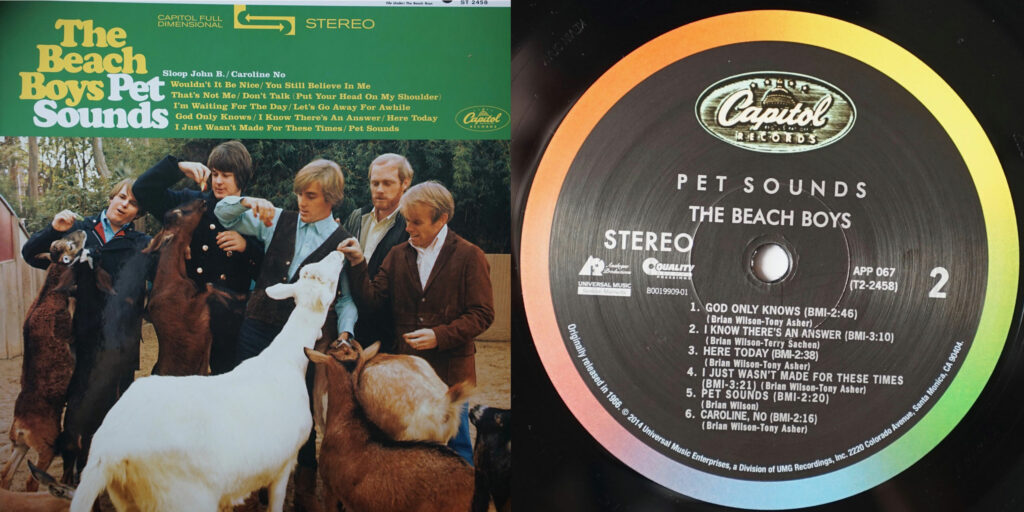
Full digital. Definitely doesn’t sound bad, which I expect it would if the Lingo 4 (which I’ve been listening to for a week) had made as huge a difference as I initially thought it was. The tympanis are maybe hitting a little less hard than I’d like. But the bass harmonica breakdown sounds great, as do the shakers.
Full vinyl. Okay, this does sound really good. Do I just have it turned up louder? But that sense of space, texture, detail, impact, presence. The tympanis are still pretty low in the mix but do sound nice and round. Bass harmonica texture is great, but it’s more the sense of space that stands out, and the natural decay of the cymbals.
Slight delay. Big difference. Flat, constrained, mushed together, clunky on digital. Wide, full, clean, clear, harder-hitting on vinyl. The difference between sugar that’s congealed into a rock while being heated versus lots of lovely, fine, separated grains of sugar. I’m going to wager that we’re into the range of the “gross.” We’ll see on the S-2-s.
Second-to-second. Nope, not gross. Definitely sense of hardness in the digital — a kind of “freeze” in the background, right behind the vocals. More natural bass (and more bass) on vinyl. Vinyl sounds clearly much better, but it’s in the 10-15% range, not 20%. I’d say it’s closer to 15% than 10%, but difference isn’t massive.
Verdict: vinyl 15% better (5% improvement)*
* This is somewhat charitable, as after my last verdict I gave the disc a distilled water bath and thought it then sounded 15% better than digital — but my official last-round verdict was 10%, so…)
2. Charles Mingus, “Track B — Duet Solo Dancers,” The Black Saint and the Sinner Lady (1963)
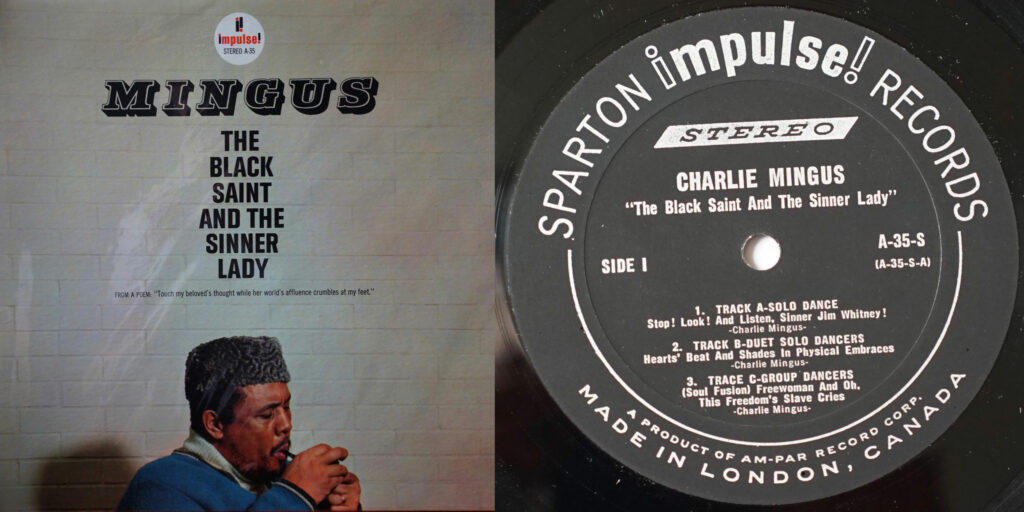
This one is going to be complicated. I’m going to listen to my reference pressing, the Sparton, but also a new-to-me VG+ 1963 US pressing that I’m considering using as a new reference. I’ll also throw in the 2019 Vital Vinyl pressing I’ve been listening to.
Full vinyl (Sparton). Graininess at the beginning, but sounds terrific. (Damn, I think there’s more surface noise on the US pressing I just bought!) The sense of groove damage I’ve gotten on previous listens doesn’t really seem to be there to the same extent. Beautiful detail in the “cordy” sax bit, nice decay on the cymbals, nice deep bass.
Full vinyl (1963 Impulse). Yeah, damn, more surface noise on this one. Life sucks (as do sellers on Discogs). But I think there’s more treble detail here. Lovely texture behind the surface noise.
Full vinyl (Vital Vinyl). Ah, beautiful quiet vinyl. Pressed much more quietly than either 1963 pressing. Less treble, less high end than either. Sounds really different, and in this back-to-back context, duller. But with the duh-duh-duh breakdown it does have a lot of force. Otherwise, though, nasal in comparison.
Full digital. Seems to have that same less lively, nasal quality as the Vital Vinyl, but with the nice powerful breakdown. I feel like I need to turn it up a little higher to get the impact I’d like.
Rather than a normal slight delay, I’ll do a second-to-second (usually the most revealing test) for each of the pressings, and give a verdict for each.
S-2-s (Sparton). The nasal quality is there on the digital piano, and the cymbals are more natural on vinyl. But the cordiness is equally good on both, and the digital has more power in the breakdown. The detail on cymbal and high end (and on drums in the quiet part) is so much more listenable and pleasant on vinyl, though, that I’ll give vinyl the slight edge. Verdict: vinyl is 5% better (5% improvement).
S-2-s (1963 Impulse). It sounds exactly the same as the Sparton. Except maybe with a bit more surface noise. I shouldn’t be surprised, since this has the same RVG stamps as the Canadian version. Pressed from the same metalwork. Anyway, also 5% better.
S-2-s (Vital Vinyl). Definitely from the same source: it’s darker, bassier than either 1963 pressing. The vinyl does indeed sound a little better, with a bit more detail and impact. As with the other pressings, the main difference is with the cymbals, which sound tinny and less “bloomy” on digital. Verdict: Same as in previous rounds, I guess: 10%. But I do prefer the balance of the 1963 pressings over the bass-heavy way this transfer was done.
So I guess I’ll keep going with the Sparton! And maybe stop worrying about the Vital Vinyl, since the Sparton seems not to have any groove damage — it’s likely just that this 1963 recording/mastering isn’t anything special.
3. The Pentangle, “Let No Man Steal Your Thyme,” The Pentangle (1968)
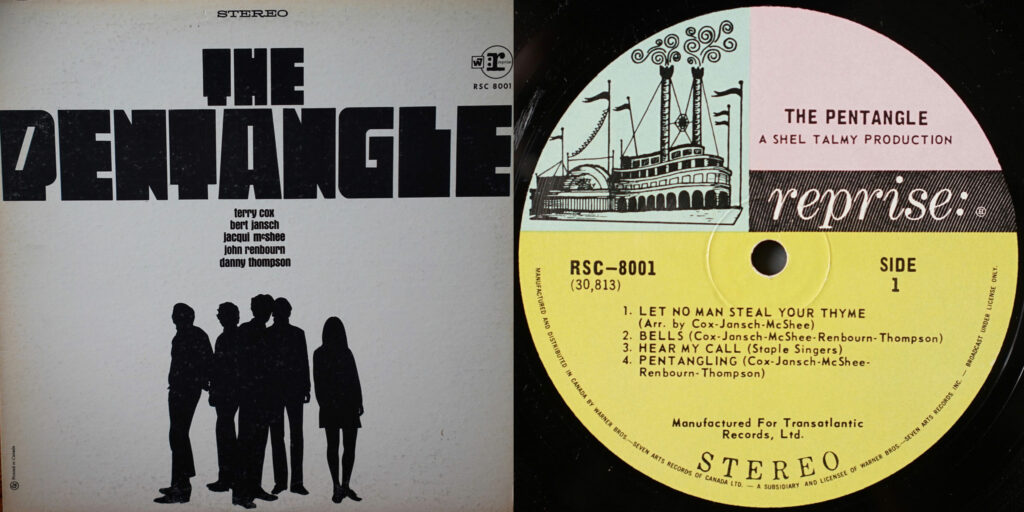
Time for another multiple-pressing comparison. I just bought a “NM” (more like VG+ — I’m so sick of Discogs!) first Transatlantic pressing and will compare it to my first Canadian Reprise pressing, which I suspect has some groove wear or just doesn’t sound that great.
Full digital. As always, sounds terrific on digital. Very lively, spacious, hard-hitting. Rim hits are as if right inside my head.
Full vinyl (Reprise). Sounds great (and geez, again, I think the surface noise is actually less on the disc I was trying to replace with a NM one!!). But muffled in comparison to the digital. The graininess I’ve complained about in previous rounds is there and stands out in comparison with the digital.
Full vinyl (Transatlantic). Okay, this disc was worth the money. Texture on the bowed bass is amazing. I’m picking up all kinds of space around Jacqui McShee’s voice. Laser focus on all the instruments. Phenomenal detail on the rim hits and, especially, on the left-channel guitar during the rim-hit/triangle part. Some surface noise on this copy, but less than the Reprise, and much nicer sounding. There is the possibility it’s just pressed much louder, though, and loudness is interfering. That’ll come out during the S-2-s tests, which I’ll do for both.
S-2-s (Reprise). Yes, the graininess on vinyl is there. But there’s a tinniness to the digital that really shows up in the rim-hits: they feel blunt, hard against the soft landing of the vinyl. More body to Jacqui’s voice on vinyl. Verdict: 5% better on Reprise vinyl (5% improvement)
S-2-s (Transatlantic). Yowzer. Massively more alive, detailed, spacious, colorful, impactful on vinyl. Right precisely at the 20% “gross” barrier, I think, but I’ll do a slight delay to confirm.
Slight delay (Transatlantic). No question, it’s all color and liveliness on vinyl, dull and grey on digital. At the very least “gross” — could be 25%. But to be conservative, let’s say 20%. Verdict: Transatlantic vinyl sounds 20% better (future listening tests will be on this pressing).
As I continue to listen to this Pentangle record… WOW!! Unbelievable sounding. Fellow audiophiles with sketchy taste in folk-jazz: avoid North American pressings and hold out for Transatlantic originals.
4. Mariah, “Shinzo No Tobira,” Utakata No Hibi (1983)

Full vinyl. Definitely amazing-sounding right from the first notes — those rattles! Full bass, tons of space. Amazing glow around the vocals. Analog synth is incredibly smooth in panning from left to right.
Full digital. The staleness, flatness is definitely really clear even outside of back-and-forth comparison. Much less impact, force. No sense of space around vocals. I’m feeling less space, definition on the analog synths.
Slight delay. Huge difference in detail and impact and texture, no doubt. Feels like “gross.” Beyond gross? Not sure.
S-2-s. In second-to-second testing, I don’t think the difference is even at the “gross” level. The levels make this one hard to compare, but nonetheless, the digital is not 20% worse. I’m going to say a solid 15%. So it’s gotten worse since the last round, huh?
Verdict: vinyl is 15% better (5% regression)
5. Joy Division, “Atmosphere,” 12″ single (1980)
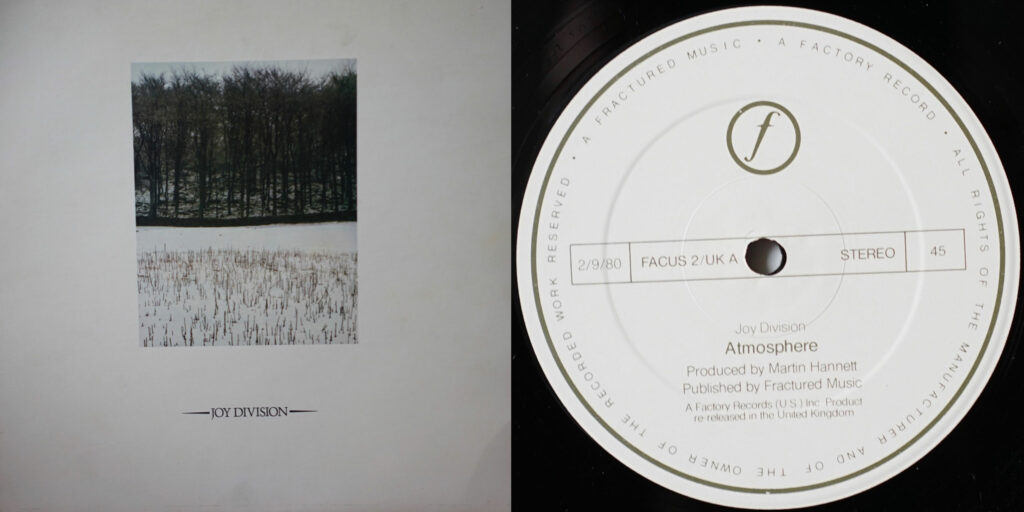
Full digital. As in previous rounds: not at all bad-sounding, but not thrilling. Drums lack maximum impact, detail, and the soundstage feels narrow.
Full vinyl. Totally amazing, refreshing, invigorating. Such a wide soundstage, with both drums LOUD while still leaving tons of space for the relatively quiet vocals to be heard and make their impact.
Slight delay. Massive, massive, massive difference. So much more detail, impact, reality, edge, bite. The critical vocabulary is the issue now. Gross? Definitely. Beyond gross? Probably. Appalling (the 30% threshold)? Probably not.
S-2-s. Confidently “beyond gross” here: space, detail. The top end especially on vinyl is much more detailed and impactful. So much more sound hitting you even at the same volume — so much more “information” coming into your ears! It sounds absolutely amazing. Not sure we’ve moved into the “appalling” level though. Until I sense a new threshold, I’m not using it.
Verdict: vinyl is 25% better (no improvement)
6. Low, “Just Make It Stop,” The Invisible Way (2013)
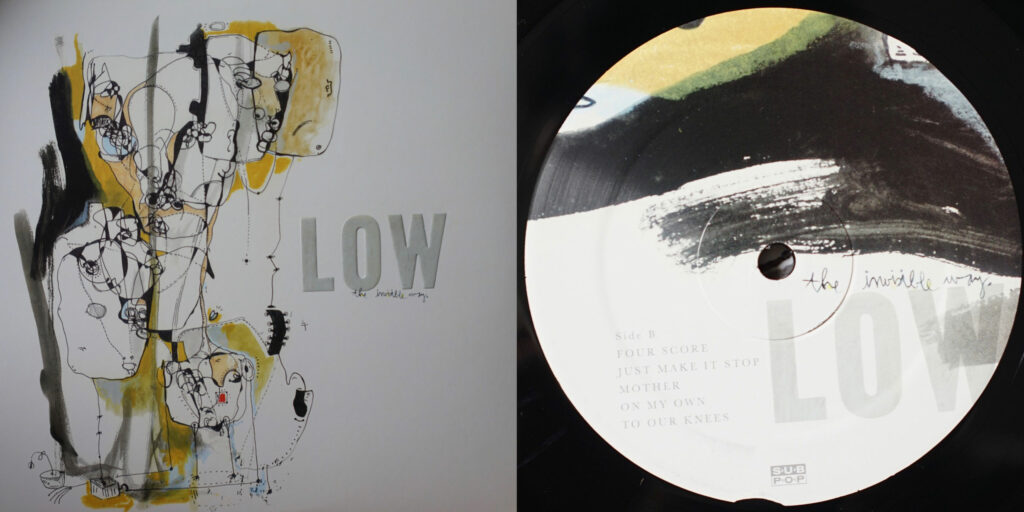
Full digital. Nice cymbal detail dead-centre (looking back over my notes, I see that’s the main thing I was complaining about last time — ha!). The soundstage seems mushy — hard time separating the instruments or seeing them positioned in space. Not a particularly pleasant listening experience — boomy, tiring.
Full vinyl. Yeah that cymbal sounds way nicer here! Real sense of space — beautiful separation. Night-and-day difference even in this usually less revealing one-after-the-ther setup. Bass from piano and muted guitar is deep but not boomy. Sounds good — like the kind of track you’d want to pick as a test track, for example!
Slight delay. Clarity, space — no comparison. Well beyond gross in moving from a huge, crystal-clear, lively sound to a muffled, dead, flat one. Clearest in the loud, busy parts. Everything becomes a mush on digital.
S-2-s. Huge difference, as above. But I’m not sure, in second-to-second, that it passes the “gross” threshold. Since I’m not absolutely sure, and in the interest of not inflating grades, I’ll keep this at 20%. Which is to say, it sounds hugely better and really amazing, but not obviously better than it sounded last round.
Verdict: vinyl sounds 20% better (no improvement)
7. Yo La Tengo, “Stockholm Syndrome,” I Can Feel the Heart Beating as One (1997)

I do three tracks in each session, so this is the start of session #3. I’ve taken a couple of days to investigate the ticking motor that’s been annoying me with the Lingo 4. Since one theory is that this ticking will go away once the motor is run in sufficiently, I thought I’d record how loud the ticking is in each of the next two sessions. Tonight, you can hear the motor ticking quietly at 33.3 with your ear up close to the platter, near the motor. It’s quiet, but you don’t have to strain to hear it. It’s there.
Full digital. Not terrible, lots of bass, but a definitely fuzzy presentation, indistinct vocals, plinky acoustic guitars. I wonder who did these digital transfers? This has to be down to bad mastering and not just to the Schiit DAC doing a bad job. I’ve been obsessing over the ticking motor in the Lingo 4 for the past few days, so I’m very eager to hear how things sound on vinyl this time — if the difference will still be 25% or will have moved back?
Full vinyl. Crisper, cleaner, more detailed. Bass is present but not boomy. Definitely much better sounding than digital, but not an absolute knockout audio experience — not one I’d say a non-Yo La Tengo fan should have on their list of test tracks, for example. The audio highlight, though, is the solo, where the narrow, distorted lead guitar is caressed by pick-strummed acoustic guitars on the edges of the soundstage.
Slight delay. Sludgy, gross, sticky, gooey, viscous on digital. James has a cold. Snare has no bite on digital, comes alive on vinyl. Digital definitely “gross” in comparison.
S-2-s. You know, I think I might finally know what 30% sounds like. I am morally offended and also spiritually deflated at how horrible the digital sounds in comparison. The vinyl is so crisp and alive and full of detail, spacious and wide and gleaming, full of fresh air. It’s possible I should have called this 30% last time, but I didn’t. I’m calling it 30% this time.
Verdict: vinyl is 30% better (5% improvement)
8. The Beatles, “While My Guitar Gently Weeps,” The White Album (1968)
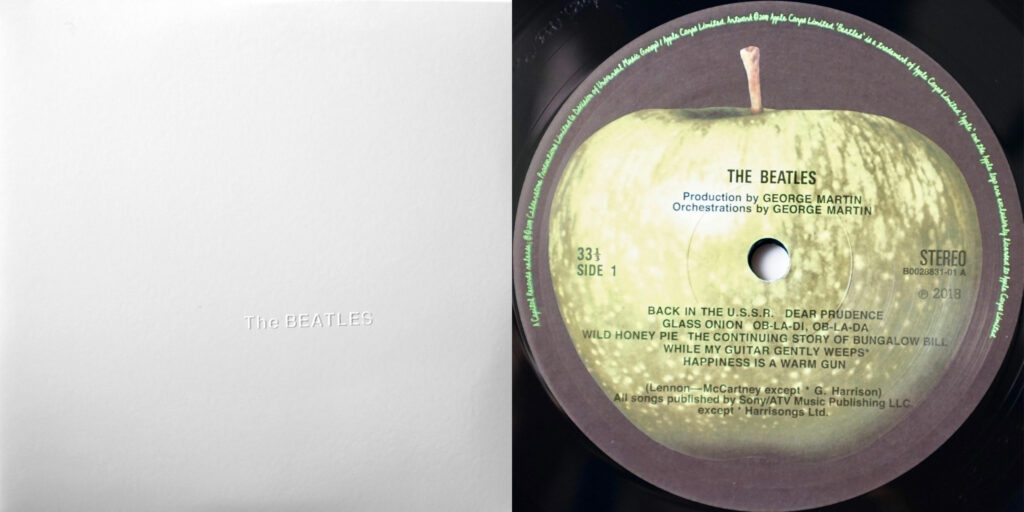
Full digital. Nothing to get excited about here. Glazy on the highs, mushy pixel-barf on the acoustic guitars, hollowness. Having watched Sideways for the first time this weekend, I can say I’m starting to develop a bit of my audio wine-tasting palette here, becoming a bit of a snob. I can sniff an indifferent audio experience now, and this is one — despite the fact that these hi-res Giles Martin remix files used to blow my socks off in my pre-vinyl-revival days.
Full vinyl. There we go. Width, extension, filigree, heft. The clippety-clop in the left channel is set apart in space and nicely detailed, the bass is huge and focused (could maybe be a little more focused), the bass drum pounds. This is a very nice audio experience — nicer than “Stockholm Syndrome” in absolute terms. The definition of the bass seems to increase a little as the song goes on, too…
Slight delay. Digital loses a lot of the atmosphere, space. Fuzzy, unfocused. I don’t think there’s as much of a relative difference here as with YLT. What vinyl has is space and clarity — digital has that sludgy echo chamber, smog effect. The detail edge on shakers and cymbals is massive.
S-2-s. The thick, full bass drum on vinyl becomes a flabby empty sack on digital. Imagine a bursting-full wineskin and one with a few drops left. The tone seems off on digital. Definitely gross. Maybe beyond gross. Not “appalling.” Clearest on bass, bass drum, and anything with treble. But when I look away and start typing these notes, it’s not immediately super-obvious which source I’m listening to (though it definitely is when A-B switching). Reading over my comments from last time, the difference seems less than I was hearing then. I’m going to say “gross” but not “beyond gross.”
Verdict: vinyl is 20% better (5% regression)
9. Dungen, “Panda,” Ta Det Lugnt (2004)

Full vinyl. I always look forward to this track. And this sounds good. A very pleasant listening experience: a “wow, everybody, use this as a test track experience.” The high end seems almost harsh this time, though. Terrific detail and bit on the left-channel electronic guitar, but the cymbals seem a little crashy, harsh. Every drum sounds incredible at every point in this song. Especially in the “descent into sonic mushroom cloud” (as I called it last time) at the end.
Full digital. Eeek. The hollowness of bad digital, especially on the drums. The only good thing I can say is that it does seem a little less harsh on the top end. The effect lessens as I go on — it becomes less offensively bad. But that hollowness doesn’t go away. No pleasure in listening to the track this way.
Slight delay. Listening to the opening on vinyl, I feel like my head is actually being sort of pleasantly knocked around, like my headphones are the drumsticks and my head is the drum. No such fanciful effect on digital, where I feel no impact, and where everything is sludged together. The contrast is less obvious in busier sections where all the instruments are blasting away. In these busy bits, the harshness of the vinyl high end can be annoying. But then in the breakdown, the drums on vinyl are so much better.
S-2-s. Differences are not subtle. So much more space, clarity, separation — as well as impact, slam on vinyl. “Gross,” yes. But again, I don’t think “beyond gross” here. My notes from last time suggest a wider gap. In the quieter parts, the vinyl really shines. In the louder parts, the difference narrows. Definitely 20%, but not 25%. (Okay, in the intro and outro it’s 25%). Not sure I’m not just looking for faults given my irritation with the ticking Lingo motor, but I really am not feeling the enthusiasm of the last round.
Verdict: vinyl is 20% better (5% regression)
10. Julee Cruise, “Rocking Back Inside My Heart,” Floating Into the Night (1989)
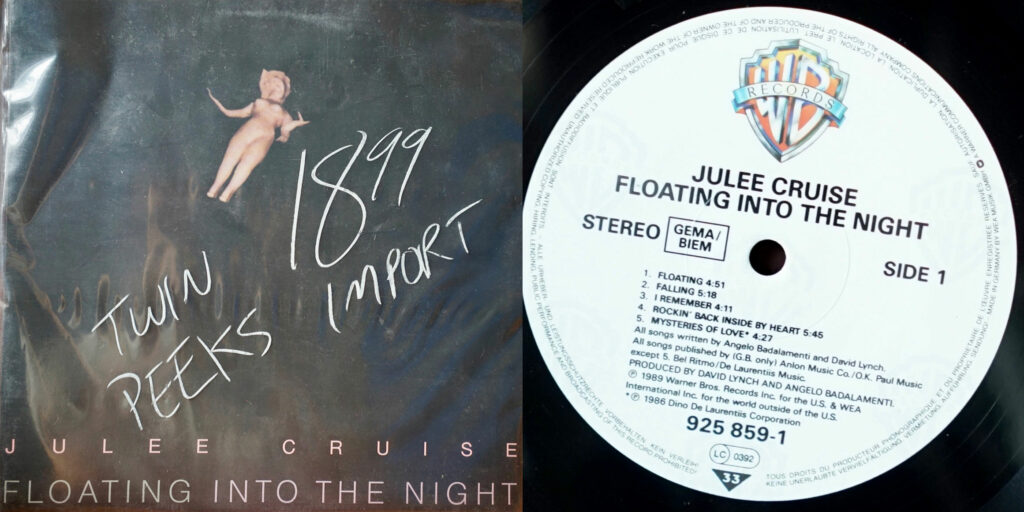
Next listening session. Motor noise is still audible (very faintly — pretty sure it’s getting quieter).
Full digital. This track sounds great on digital. Smooth, easy, with lots of bass and crisp highs — then a glaringly rough, knotty sax intrudes. Another one of those situations where it sounds so nice on digital that I have a hard time imagining how the vinyl is going to sound 20% better, as it did last time.
Full vinyl. Yeeeaaaahhh, that is nicer. So much clarity and detail and added space. This process is so much more fun when one sounds good and the other sounds AMAZING, as opposed to “Stockholm Syndrome,” where one sounds terrible and the other sounds very good. I wouldn’t say this necessarily stands out as 20% better than the digital track outside of direct A-B, but it’s clearly much crisper and wider. And yeah, that knotty sax really does jump out, and the sax breakdown is nuts — just incredibly wide and detailed.
Slight delay. Clarity and high-end detail really separate them. Definitely much better on vinyl. 15% rather than 20%? Well, that sax breakdown is definitely more like 20-25% better. Overall, I would call the difference “gross” — just barely in that space. Switching from vinyl to digital, things get cloudy, dull, mushed together, blunted. Better definition on the sub-bass run right before “Do you remember?” If I listen to just digital for a while, I get used to it and think it sounds good. Then when I switch to vinyl, things open up, spread out.
S-2-s. Most of the way through, it feels more 15% than 20%. In the sax breakdown, it’s massive — I make the gross face. We’re teetering between the 15% and 20% difference, but I think just slightly closer to that “gross” threshold most of the time. It comes down to the hollowness and lack of impact on digital, the tactile liveliness of the vinyl.
Verdict: vinyl sounds 20% better (no change)
11. Can, “Halleluwah,” Tago Mago (1971)
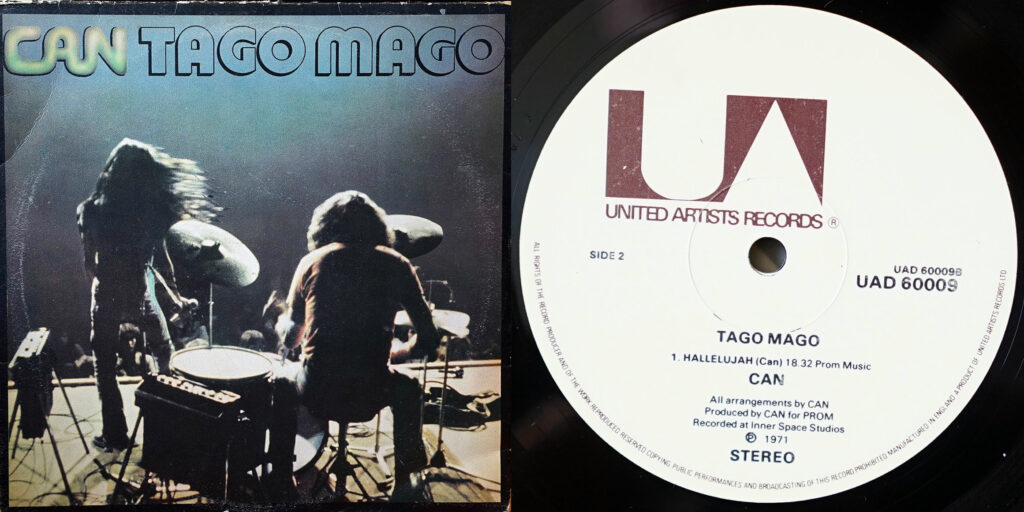
Full digital. Hey, that’s what I needed — a shot of energy! I love this song. It’s definitely slamming on digital, although I also hear a slightly hard, glassy quality to the drums that I would definitely enjoy not hearing.
Full vinyl. Honestly, sounds a little foggy, congested. The harsh quality from the drums isn’t there, but there’s a kind of soft focus. Okay, that seems to diminish once we get into the harder drum sounds, where the impact gets more direct. Not really rocking my world in terms of drum sounds. The subtle details (sound effects, echoes, funny little synth noises) sound really good and in excellent focus, but the drums aren’t like the ones in “Panda” or “Atmosphere” — not that incredible sense of roundness. Hmm, well, at times that sense does come up — the bass drum (doubled with a bass guitar?) goes really low and with focus. The clattery shaker sounds heading into the quiet hard sound very good — like you can reach out and touch them. Killer “tickle sounds” afterward. Okay, enough of this vague, all-over-the-place spewing — I need to listen to them back-to-back.
Slight delay. More, nicer bass on vinyl, also lots more definition on the left-track cymbal. Digital isn’t horrible, though — just a little foggy compared to the vinyl. Okay, on the first drum breakdown around 2:15, the gap widens. Way more space and impact on vinyl. Chalky, grey-filtered on digital. There are definitely parts of the song where the production is better — where is just sounds better. Vinyl really nails these good-sounding parts, and you notice the difference between them. On digital, everything is about equally pleasant No question, switching back and forth, I’m making the barfing motion most of the time. Gross, maybe. Definitely not “beyond gross.”
S-2-s. The opening does not sound better on vinyl — for some reason it sounds dull on my pressing — but things rapidly pick up. Soon the vinyl has way more impact on drums as well as placing delicate sounds much more precisely in space. It’s only at about 2 minutes in that vinyl pulls away from like 10% better to more like 15%. Still not “gross” at this point. Even at the “clattering” sounds it’s more like 15%. The advantage holds steady from there out — vinyl rounder, more detail, more spacious. I’m struggling to see this as “gross,” though. No, in direct A-B, it’s not. 15% only.
(I know it must be annoying and boring to read about someone debating with himself whether what he’s hearing is “gross” or not. But I must say, I have a pretty clear sense by now of the difference between 15% and 20% — and this is 15% in second-to-second A-B. Digital is lots worse in comparison, but not “gross.”)
Verdict: vinyl sounds 15% better (5% regression)
12. Bill Callahan, “Javelin Unlanding,” Dream River (2013)
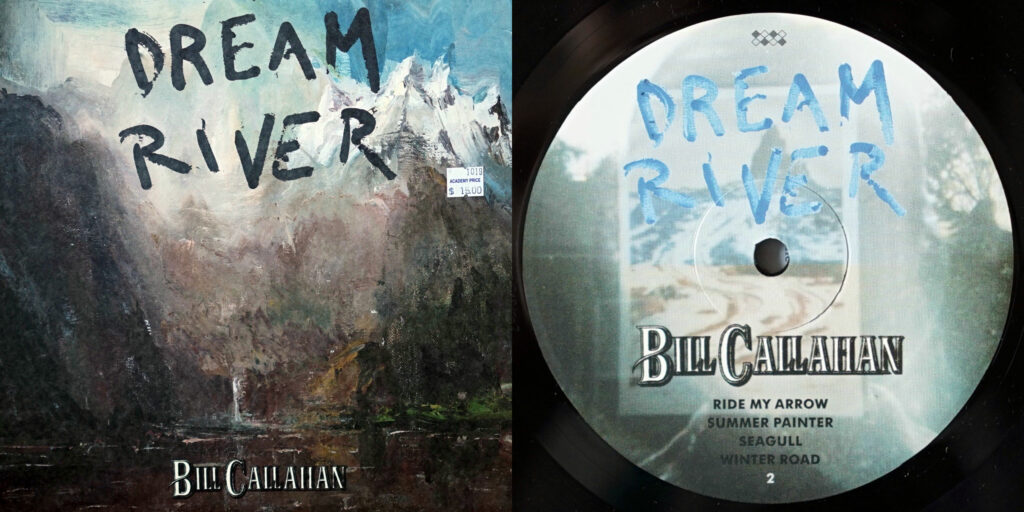
Full vinyl. BC’s voice sounds terrific. Some of the backing instruments sound a little plinky, under a little layer of oil, perhaps deliberately. Yeah, the guitar comes in very clearly during the chorus — the oiliness of the early parts, the slight flatness of the flute, must be a choice, to contrast with the more clearly drawn lead vocal, lead guitar, and clippety-clop percussion.
Full digital. Flatter, no question. I got distracted by an email and found myself nodding my head, though, so it can’t have been all bad. Time to see in direct comparisons…
Slight delay. Okay, yeah, digital’s getting killed here. Too bassy, too muddy, total lack of subtlety in presentation of quieter textures and sounds. Space is foggy, congested on digital. Yuck.
S-2-s. The difference is there, but it’s not “beyond gross.” I hear it, and it’s real, but it’s in the 15%-20% better range. I wish I could go back a few weeks and hear this track exactly as I heard it then and see if I’m just getting harsher, or more accustomed to excellent sounds, or hung up on the (now barely audible) sounds coming out of the motor. But what I’m hearing does not correspond to my listening notes from last time.
Verdict: vinyl sounds 20% better (5% regression)
Next steps
This whole “run the motor in long and it will eventually quiet down” thing has really thrown a wrench into my plans. Naturally I want to get on to my next tests: the Mober SSP12 subplatter, the Mober bearing, the Aro, the Ekos, the MC cartridges…
But I might as well see if the Lingo 4 motor eventually settles down. I’m going on vacation soon for a couple of weeks, so I’m going to leave the Lingo running while I’m away. When I return, it will have been running continuously for a month. If that’s not enough time for it to settle down, I don’t know what is. And I don’t think anyone could say I haven’t given it a fair chance by that point! If it has quieted down, I’ll do another listening test and see if there’s any difference in sound quality.
I also have a Mober DC motor kit coming to me in the mail — once the Hong Kong post office opens up again after the coronavirus closure, that is. Given the fact that a noisy motor will really mess with all future steps, I’ll probably swap that in as soon as it arrives.

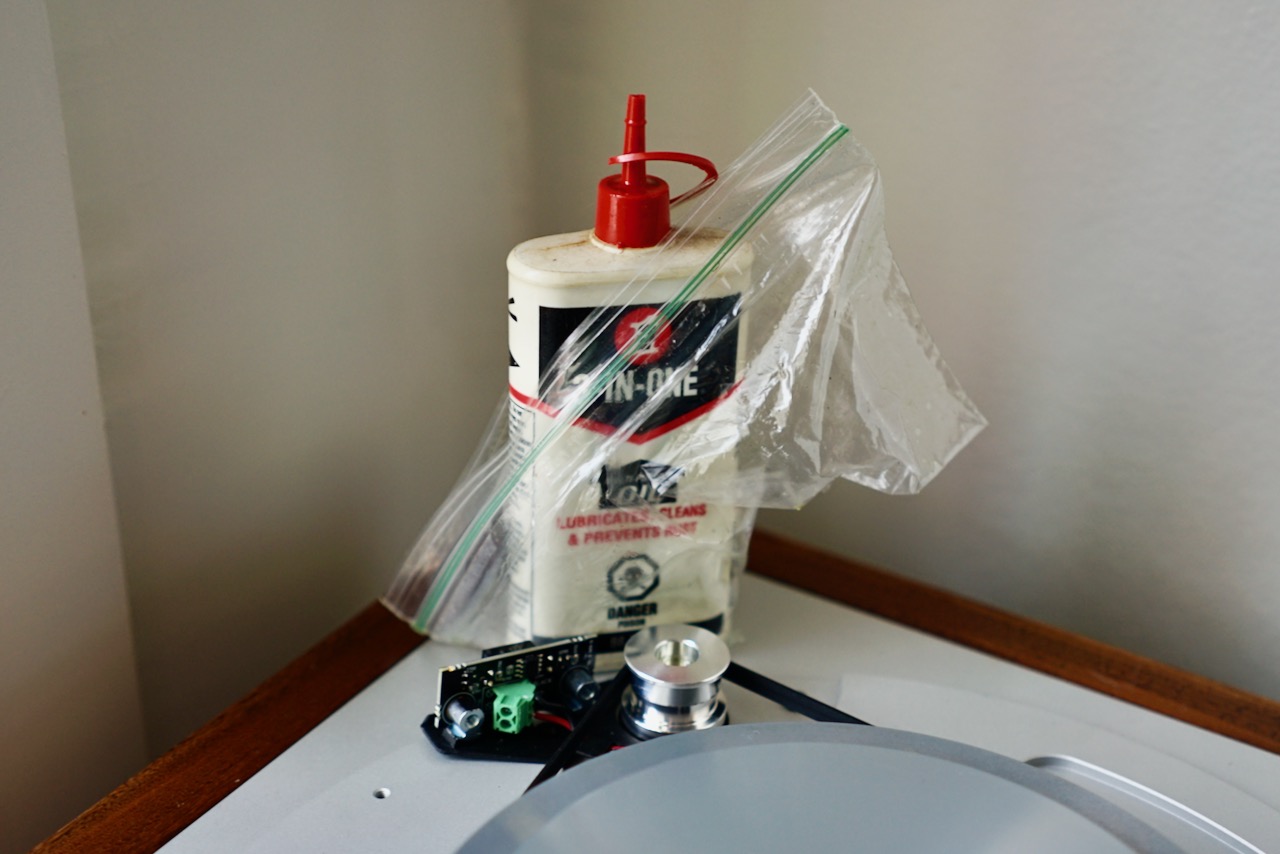
6 Comments
Join the discussion and tell us your opinion.
Sorry to hear of your bad luck. That noise isn’t right. You’ve got a defective motor. That’s undoubtedly why the original owner sold it to you – I don’t buy the “open box but never installed” tale he told you!
Any followup?
I’m sure you’ve seen the posts on Lejonklou regading the grounding issue with the Lingo 4. I’m guessing yours didn’t have the “fix” applied (cutting the ground link on the XLR socket). I don’t know if your observed poor performance, sound quality wise, was due to the defective motor or, at least in part, to the ground loop?
Hi Keith,
Yes, I did see those posts. I didn’t notice any grounding issues with mine, but I never did try the mod. As coincidence would have it, a brand new replacement Lingo 4 is supposed to be arriving at my house today. I will most likely just sell it without trying it out, though — I’ve endured enough trauma with the Lingo 4 and don’t want to decrease its value by installing it at this point!
Oh, no! I understand why you don’t want to mess with it any further – it’s been a long, drawn out process. But I’m sure lots of your followers are chomping at the bit to hear the final chapter of this episode! 😉
I’m slowly talking myself into giving it a shot 🙂 The motor has now arrived. I probably won’t be able to resist trying it out — especially since it all came to me not in its original box, so the horribly painful prospect of breaking that seal and having the value diminish won’t happen. Also, the dealer I bought it from promised to have tested it out — another thing I’ve been dreading is putting it all bath together and hearing “tick, tick, tick.”
Fingers crossed!